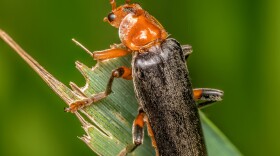Bug Bytes
Giant Salmonfly (Pteronarcys californica)
The first one we saw looked like a toy helicopter coming in for a crash landing.
Then …we noticed them everywhere. Flying with a clumsy, erratic flight. Crawling on branches and rocks. And soon enough, crawling on us!
It results in a feeding frenzy for fish and birds. It’s such a valuable food resource that animals like peregrine falcons and bears have been observed taking advantage of the easy, protein packed food source.
If you’ve ever been along a river, and fortunate to catch the peak of the Giant Salmonfly hatch, it’s an experience you’ll never forget.
At 3 inches in length, Giant Salmonflies are hard to miss. In addition to their massive size, the bright orange band behind their heads and orange coloration of their underside makes them one of the easiest species of stoneflies to identify.
While their winged, adult life-stage is certainly impressive, it only represents a tiny portion of the Giant Salmonfly’s lifecycle. They spend 3 to 4 years as a nymph, living on the bottom of fast flowing streams and rivers where they feed on leaves and other organic material in the spaces between rocks.
Starting in late-May to early July in rivers across western North America, nymphs that are ready to emerge will do so in mass. Crawling out of the water and onto vegetation along the river bank, they split their exoskeletons (leaving their nymphal lives behind) and emerge as adults to take to the air.
Even if you miss the timing of this epic hatch, take a close look at the streamside vegetation. You’re likely to find their shed exoskeletons all over the place …sort of like a Christmas Tree adorned with some creepy looking ornaments.





